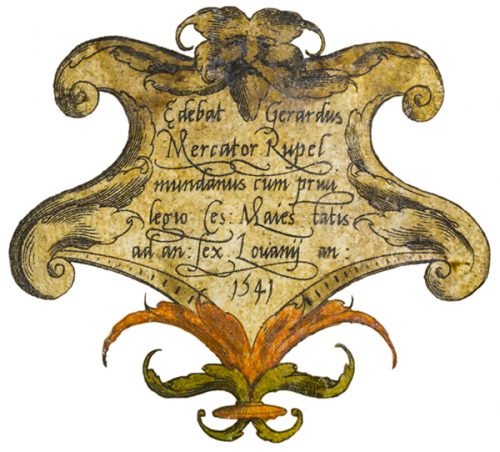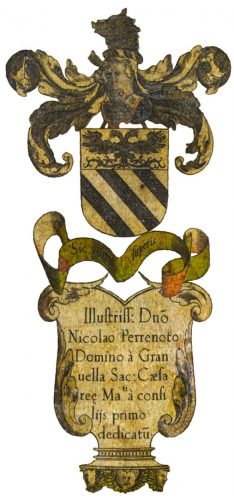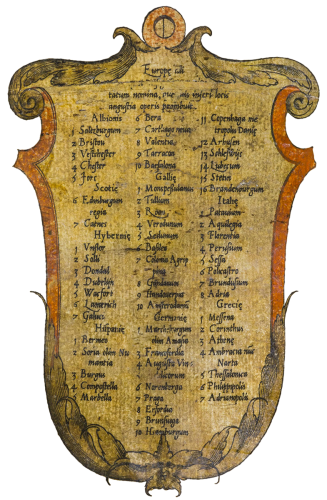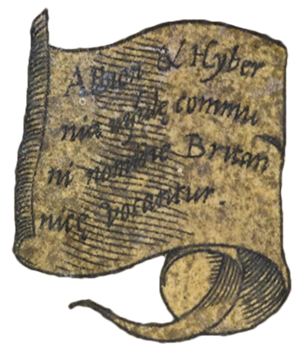Insets
The terrestrial globe has seven text insets. Most are actually captions, a bit longer than usual, dealing with geographic features. Two others provide information on the globe’s design.
Perrenot was an important figure in his time. He was chancellor in the court of Charles V and even a close adviser to the emperor. By 1541 he had held the position of guardian of the seals for nine years. On the globe, above Mercator’s dedication, are the Lord of Granvelle’s coat of arms and the words Sic visum superis (“Thus you will see the world from above”).
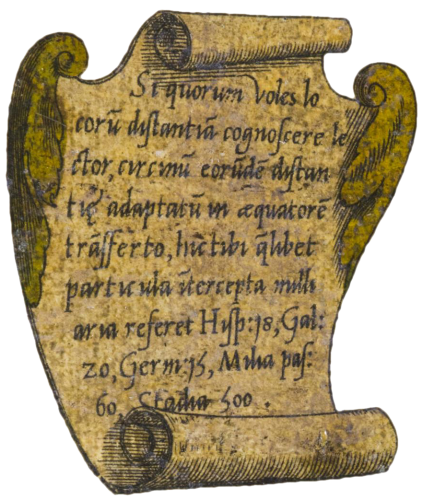
Si quorum voles locoru[m] distantia[m] cognoscere lector, circinu[m] eoru[m]de[m] distantiae adaptatu[m] in aequatore[m] transferto hic tibi q[ua]libet particula i[n]tercepta mille aria referet Hyp:18, Gal:20, Germ:15, Milia pas:60, Stadia:500
Here are the names of a few famous cities in Europe that lack of space prevented Mercator from indicating below their position.
1 Saltzburgum (Salisbury)
2 Bristou (Bristol)
3 Vestchester
4 Chester (Chester)
5 Jorc (York)
Scotiae (Scotland)
6 Edinburgum regia (Edinburgh)
7 Catnes
Hyberniae (Ireland)
1 Unflor
2 Solli
3 Dondal (Dundalk)
4 Dubelyn (Dublin)
5 Wacfort (Wateford)
6 Lamerich (Limerick)
7 Galuei (Galway)
1 Bermeo (Bermeo)
2 Soria olim Numantia (Soria formerly Numance)
3 Burgus (Burgos)
4 Compostella (Compostelle)
5 Marbella (Marbella)
6 Bera
7 Carthago nova (Cartagena)
8 Valentia (Valencia)
9 Tarracon (Tarragona)
10 Barsalona (Barcelona)
Galliae (Gaule)
1 Monspessulanus (Montpellier)
2 Tullium (Toul)
3 Roari (Rouen)
4 Verodunum (Verdun)
5 Sedunum (Sion)
6 Basilea (Basel)
7 Colonia Agrippina (Cologne)
8 Gandanum (Ghent)
9 Amsterodamum (Amsterdam)
1 Marcheburgum olim Amasia
3 Francofordia (Frankfurt)
4 Augusta Vindelicorum (Augsburg)
6 Norenberga (Nuremberg)
7 Praga (Prague)
8 Erfordia (Erfurt)
9 Brunsuiga (Brunswick)
10 Hamburgum (Hambourg)
11 Copenhaga metropolis Daniae (Copenhagen capital of the Danes)
12 Arhusen (Aarhus)
13 Schlesibyc (Schelswig)
14 Lubecum (Lübeck)
15 Stetin (Szczecin)
16 Brandenburgum (Brandebourg)
1 Patavium (Padova)
2 Aquilegia (Aquila)
3 Florentia (Florence)
4 Perusium (Perugia)
5 Sessa
6 Policastro (Policastro Bussentino)
7 Brundusium (Brindisi)
8 Adria
Greciae (Greece)
1 Messena (Messina)
2 Corinthus (Corinth)
3 Athenae (Athens)
4 Ambracia nunc Narta (Ambracie now Nartë)
5 Thessalonica (Thessaloniki)
6 Philippipolis
7 Adrianopolis (Edirne)
The islands of Albion and Hybernia, commonly referred to as the British Isles.
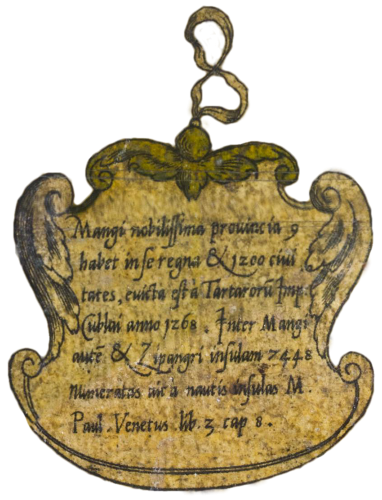
Mangi nobilissima provincia 9 habet in se regna & 1200 civitates, evicta est a Tartaroru[m] Imp[eratore] Cublai anno 1268. Inter Mangi aute[m] et Zipangri insulam 7448 numeratas ait a nautis insulas M. Paul. Venetus lib. 3. cap. 8.
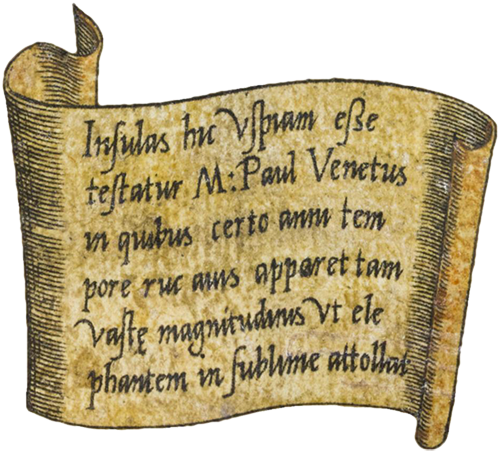
Insulas hic uspiam esse testatur M. Paul. Venetus in quibus certo anni tempore ruc avis apparet tam vastae magnitudinis ut elephantem in sublime attollat
Paulus Venetus states that there are islands somewhere in this area. At certain times of the year one can observe the rokh, a bird so large that by accounts it can lift an elephant into the air.
